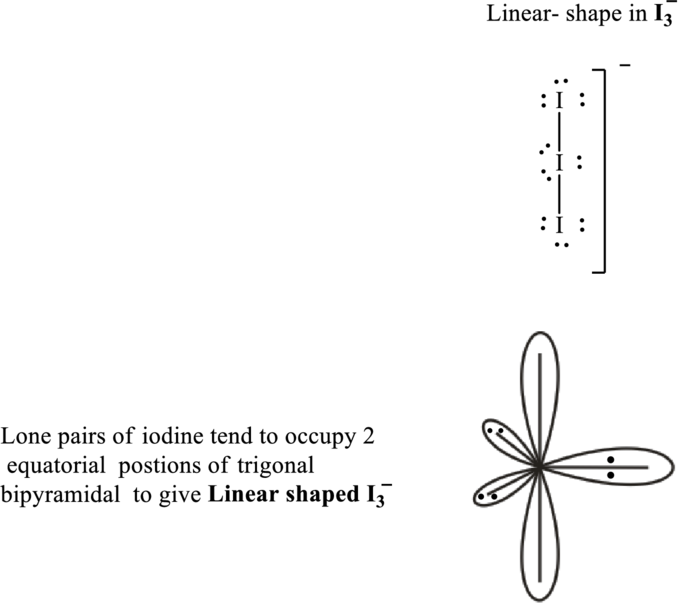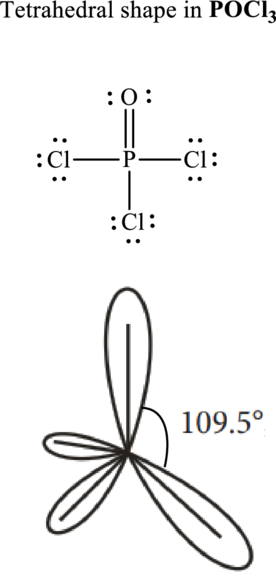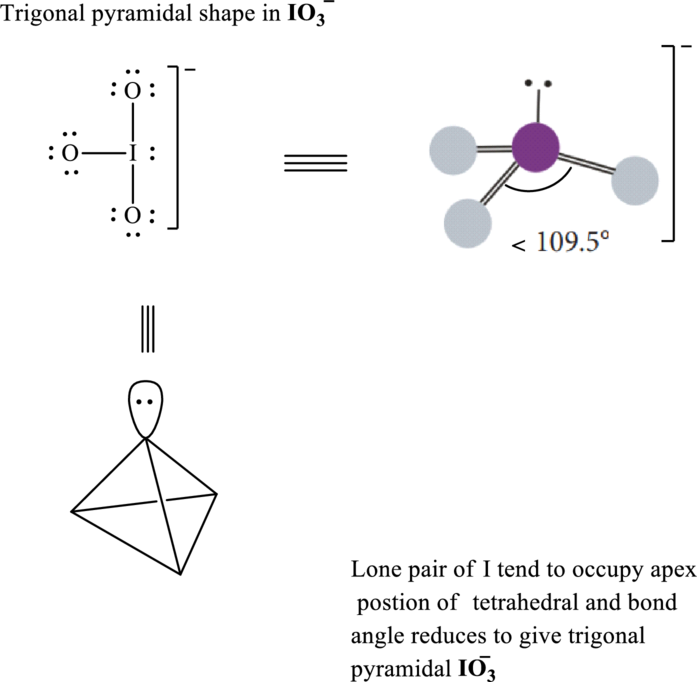
Concept explainers
(a)
Interpretation:
The VSEPR formula and shape for
Concept Introduction:
Valence Shell Electron Pair Repulsion model predicts shape by inclusion of bond angles and most distant arrangement of atoms that leads to minimum repulsion. For the molecules that have no lone pairs around the central atom the bonded-atom unshared -pair arrangement is decided by the table as follows:
In order to determine the shape the steps to be followed are indicated as follows:
- 1. Lewis structure of molecule should be written.
- 2. The type electron arrangement around the central atom should be identified around the central atom. This essentially refers to determination of bond pairs and unshared or lone pairs around central atoms.
- 3. Then bonded-atom unshared -pair arrangement that can maximize the distance of electron pairs about central atom determines the shape.
For molecules that have lone pairs around central atom, lone pairs influence shape, because there are no atoms at the positions occupied by these lone pairs. The key rule that governs the molecular shape, in this case, is the extent of lone –lone pair repulsions are far greater than lone bond pair or bond pair-bond pair repulsions. The table that summarized the molecular shapes possible for various combinations of bonded and lone pairs are given as follows:
(a)
Answer to Problem 2E.13E
The shape for
Explanation of Solution
Total valence electrons are sum of the valence electrons on each atom in
The skeleton structure in
These 9 electron pairs are allotted as lone pairs of each of the iodine atoms to satisfy their octet. Hence, the Lewis structure in

It is evident that in
If lone pairs are represented by E, and other attached bond pairs by X, then for any linear species the VSEPR formula is predicted as
(b)
Interpretation:
The VSEPR formula and shape for molecule has to be predicted.
Concept Introduction:
Refer to part (a).
(b)
Answer to Problem 2E.13E
The shape for
Explanation of Solution
Total valence electrons are sum of the valence electrons on atom in
The skeleton structure in
These 12 electron pairs are allotted as lone pairs or multiple bonds to satisfy respective octets. Hence, the Lewis structure in

It is evident that in
If lone pairs are represented by E, central atom with A and other attached bond pairs by X, then for any tetrahedral species the VSEPR formula is predicted to be
(c)
Interpretation:
The VSEPR formula and shape for
Concept Introduction:
Refer to part (a).
(c)
Answer to Problem 2E.13E
The shape for
Explanation of Solution
Total valence electrons are sum of the valence electrons on atom in
The skeleton structure in
These 10 electron pairs are allotted as lone pairs to each of the oxygen to satisfy its octet. Hence, the Lewis structure in

It is evident that in
Lone pairs tend to be localized on apical position while
If lone pairs are represented by E, central atom with A and other attached bond pairs by X, then for any trigonal pyramidal species the VSEPR formula is predicted as
(d)
Interpretation:
The VSEPR formula, shape for the Lewis structure of
Concept Introduction:
Refer to part (a).
(d)
Answer to Problem 2E.13E
The shape for
Explanation of Solution
Total valence electrons are sum of the valence electrons on each atom in
The skeleton structure in
These 6 electron pairs are allotted as lone pairs or double bonds on each of the atom in

It is evident that in
If central atom is represented by A, and other attached bond pairs by X, then for any linear species the VSEPR formula is predicted as
Want to see more full solutions like this?
Chapter 2 Solutions
Chemical Principles: The Quest for Insight
- It is possible to write a simple Lewis structure for the SO42- ion, involving only single bonds, which follows the octet rule. However, Linus Pauling and others have suggested an alternative structure, involving double bonds, in which the sulfur atom is surrounded by six electron pairs. (a) Draw the two Lewis structures. (b) What geometries are predicted for the two structures? (c) What is the hybridization of sulfur in each case? (d) What are the formal charges of the atoms in the two structures?arrow_forwardIf the dipole moment of a diatomic molecule is found to be 1.04 D, and its bond length is found to be 124 pm, what is the fractional charge on the atoms of the molecule in Coulombs (C)?arrow_forwardDescribe the structure of a P2 molecule in valence-bond terms. Why is P4 a more stable form of molecular phosphorus than P2?arrow_forward
- How would you describe the molecular geometry of C2H2F2, and what are its bond angles?arrow_forwardWhat are the favored geometrical arrangements for ABn molecules for which the A atom has 2, 3, 4, 5, and 6 pairs of electrons in its valence shell?arrow_forwardWhat are the hybridizations of nitrogen in NF3 and NH3 respectively?arrow_forward
- For the carbonate ion, CO3 2−, draw all of the resonance structures. Identify which orbitals overlap to create each bond.arrow_forwardDetermine the number of valence electrons in sulfuric acid (H₂SO₄) and then draw the corresponding Lewis structure (with minimized formal charges).arrow_forwardWhat atomic or hybrid orbitals make up the bond between C and O in carbon dioxide, CO2 ?arrow_forward
- Draw the Lewis structure of HClO₃ (with minimized formal charges) and then choose the appropriate pair of molecular geometries of the two central atoms. Your answer choice is independent of the orientation of your drawn structure.arrow_forwardDraw the Lewis structure of phosphate (PO₄³⁻) by following the octet rule on all atoms and then determine the hybridization of the central atom.arrow_forwardWhat is the hybridization of the central atom in the Lewis structure for XeF2?arrow_forward
 Chemistry: The Molecular ScienceChemistryISBN:9781285199047Author:John W. Moore, Conrad L. StanitskiPublisher:Cengage Learning
Chemistry: The Molecular ScienceChemistryISBN:9781285199047Author:John W. Moore, Conrad L. StanitskiPublisher:Cengage Learning Chemistry: Principles and PracticeChemistryISBN:9780534420123Author:Daniel L. Reger, Scott R. Goode, David W. Ball, Edward MercerPublisher:Cengage Learning
Chemistry: Principles and PracticeChemistryISBN:9780534420123Author:Daniel L. Reger, Scott R. Goode, David W. Ball, Edward MercerPublisher:Cengage Learning Chemistry: Principles and ReactionsChemistryISBN:9781305079373Author:William L. Masterton, Cecile N. HurleyPublisher:Cengage Learning
Chemistry: Principles and ReactionsChemistryISBN:9781305079373Author:William L. Masterton, Cecile N. HurleyPublisher:Cengage Learning


